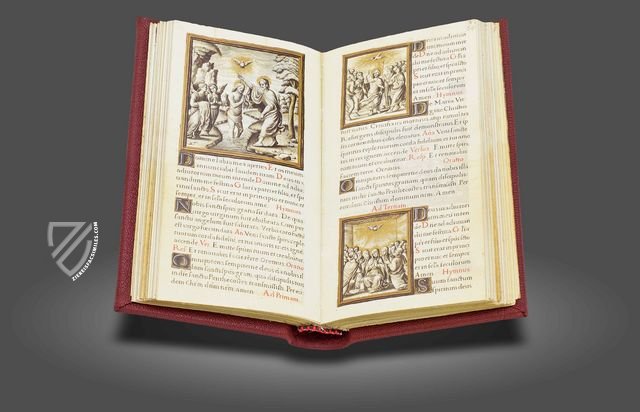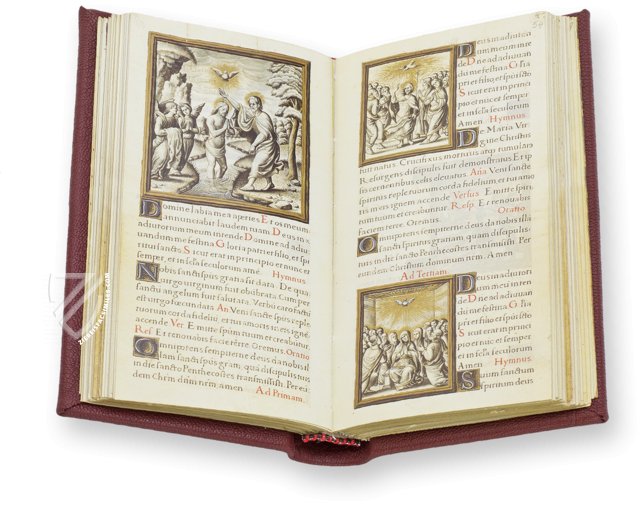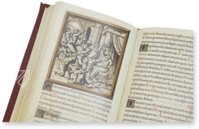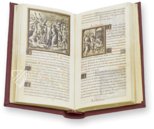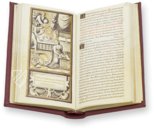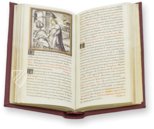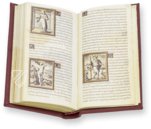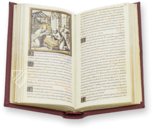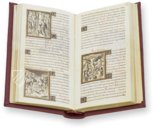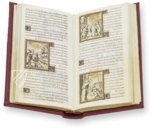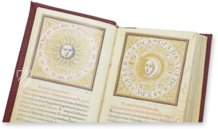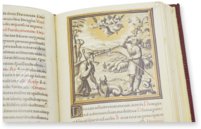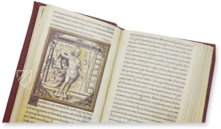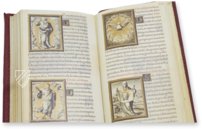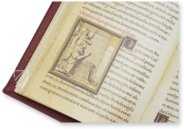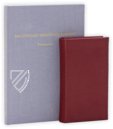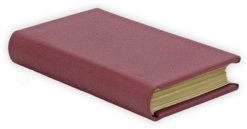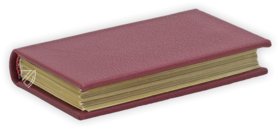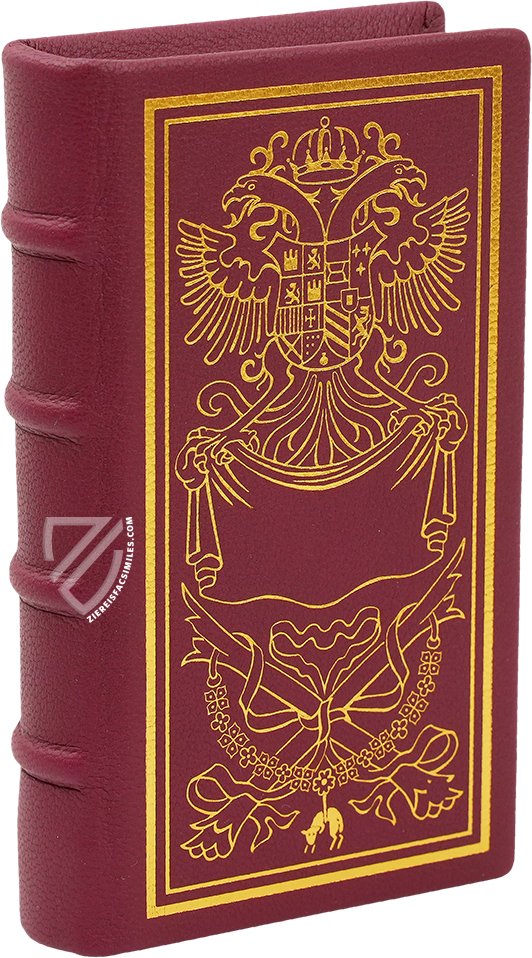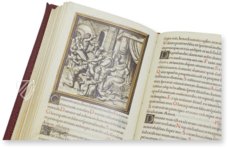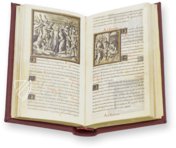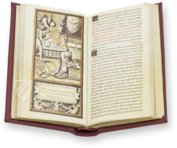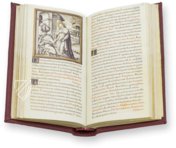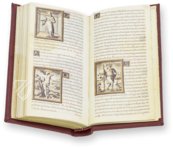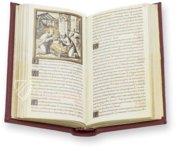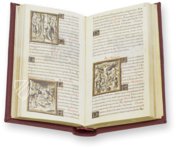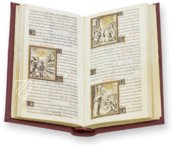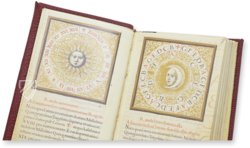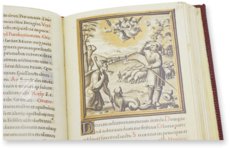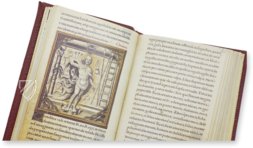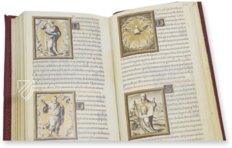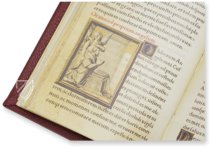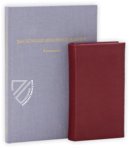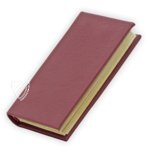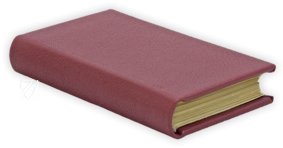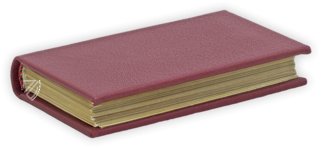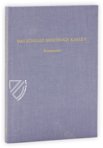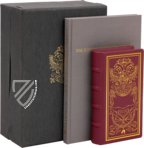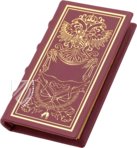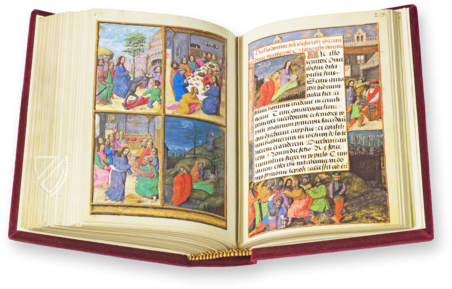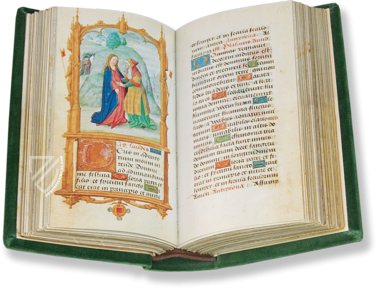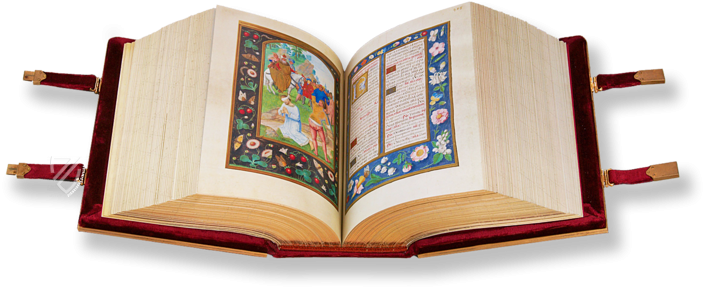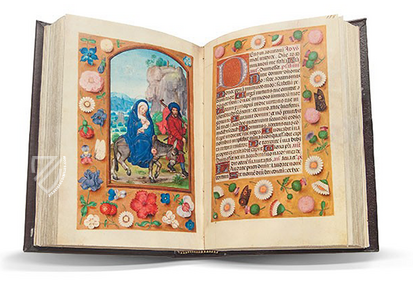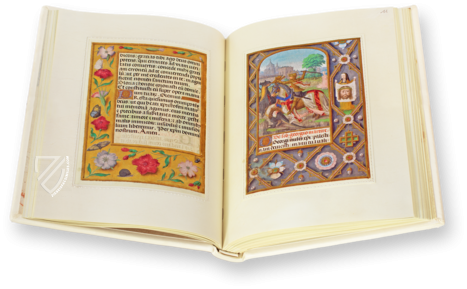Younger Prayer Book of Charles V
(under 1,000€)
Emperor Charles V was one of the most powerful European monarchs in history, with lands ranging from Austria to the Netherlands to Spain and all the way to the New World. He was also one of the greatest patrons of the arts, so much so that his prayer books, aside from his other illuminated manuscripts, have to be distinguished from one another, though all are masterpieces in their own right. The Younger Prayer Book of Charles V belongs to the most precious monuments of the late period of Flemish book painting, and originated ca. 1540. All decorative elements and miniatures are executed in grisaille where gold highlights and fine shades of dark and bright grey lend the monochrome painting plastic vivacity. The Younger Prayer Book of Charles V constitutes an important milestone in the development of Flemish book painting after 1530, because it documents a strong Italianate influence alongside the inherited Gothic tradition.
Younger Prayer Book of Charles V
The Younger Prayer Book of Charles V belongs to the most precious monuments of the late period of Flemish book painting. It was made for the Emperor after 1540 in a workshop in Flanders, where the art of book illumination still flourished in unbroken continuity, long after book printing had triumphed and hand-made books had become increasingly rare.
Gold and Grisaille
The beauty of the prayer book and its artistic decoration are convincing. All decorative elements and miniatures are executed in grisaille where gold highlights and fine shades of dark and bright grey lend the monochrome painting plastic vivacity. The reduced colors and the rich use of gold make this precious devotional book an object of truly noble charm and sumptuous art. The contents of the prayer book essentially correspond to the structure of a book of hours, which is generally based on the devotion to the Virgin and numerous other pious prayers. The work is introduced by a calendar. The text is enlivened with red rubrics and prayer titles, often with red majuscules. It contains numerous initials, 429 in total, all shaded in grey on a black ground, which is filled with gold sand and framed with golden lines. Both the renascence script and the illustrations are derived from Italian models and form a rare stylistic harmony. The pictorial decoration comprises three full-size title pages, two astronomic clocks, two vignettes and a total of 73 miniatures, all framed with three-dimensional profiles, and composed to accompany and illustrate the pious prayers.
Picture and Text in a Harmony of Style
The text is written in humanistica formata, a renascence script in clear shape with well-proportioned letters, which goes back to a print type antiqua of Italian influence. As the miniatures in the codex also betray Italianate sources, the picture and the text unite in perfect harmony. The miniatures of the Younger Prayer Book of Charles V appear as framed devotional pictures inlaid in the text. Their scenic and architectural backgrounds provide an impression of three-dimensionality and the beholder’s look falls from the flat text page through the wooden frame into the depth of the picture. The small initials snuggled on the frames remain, however, on the flat surface.
Elegance and Brilliant Decoration
The Younger Prayer Book of Charles V was made about two decades after the Older Prayer Book and is radically different in terms of layout and coloring. Many full-length pictures or full and half page miniatures are either reduced to half-length figures or busts or shrunk to a smaller size. Even the framing of the miniatures is different in the Younger Prayer Book, as miniature and prayer incipit are no longer paired, but the miniatures are composed into narrow frames with golden brown borders to lend the picture a hint of plasticity.
Influenced by Italian masters
The Younger Prayer Book of Charles V constitutes an important milestone in the development of Flemish book painting after 1530, because it documents a strong Italianate influence alongside the inherited Gothic tradition. With this book of hours, we preserve a work of art to document what is to many a surprising facet of Flemish book illumination. The reduced exuberance of its decoration and the restrained coloring enhancing the golden highlights lend the work a noble character appropriate to a prayer book for an emperor in his mature age.
Codicology
- Alternative Titles
- Das jüngere Gebetbuch Kaiser Karls V.
Jüngeres Gebetbuch Kaiser Karls V.
Second Prayer Book of Charles V - Size / Format
- 248 pages / 14.0 × 7.5 cm
- Origin
- Belgium
- Date
- After 1540
- Epochs
- Style
- Genre
- Language
- Illustrations
- 3 full-page frontispieces, 2 astronomical watches, 2 vignettes, 73 miniatures with gold ornaments and 429 initials
- Patron
- Charles V, Holy Roman Emperor and King of Spain (1500–1558)
Younger Prayer Book of Charles V
Nativity Scene
Mary and Joseph are shown kneeling on either side of the manger in awe of the baby Jesus as a donkey and an ox look on. The Virgin and her miraculous child both have golden auras while Joseph merely has a simple halo. Employing gold ink is especially effective in combination with the grisaille style due to its lack of color and emphasis on shading. Incomplete buildings in the background make it appear as though they have found shelter on a construction site.
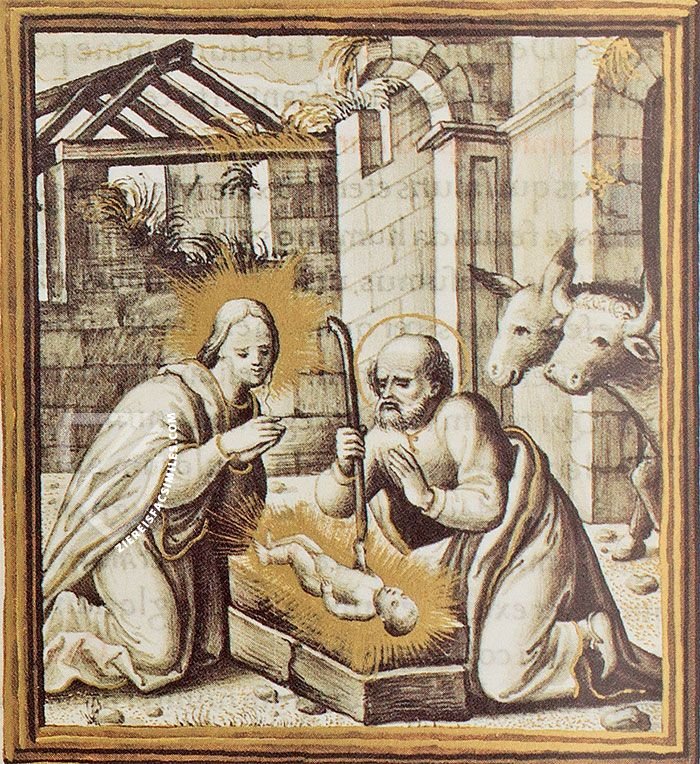
Younger Prayer Book of Charles V
Arrest of Jesus
This marvelous specimen of the grisaille technique bridges the transition from Gothic to Renaissance illumination and is masterfully shaded and highlighted with strokes of gold ink. The miniature compresses the events in the garden of Gethsemane, simultaneously showing the kiss of Judas and his arrest as the soldiers lay hands on Jesus and grapple with his disciples.
Unlike most depictions of this famous episode from the Passion, which focus on Christ’s calm resignation at the fulfillment of his own prophecy of betrayal, this scene is remarkable for its chaos and violence. Christ is an island of grace amidst a sea of brawling men dressed as contemporary mercenaries armed with clubs, swords, torches, spears, and halberds.
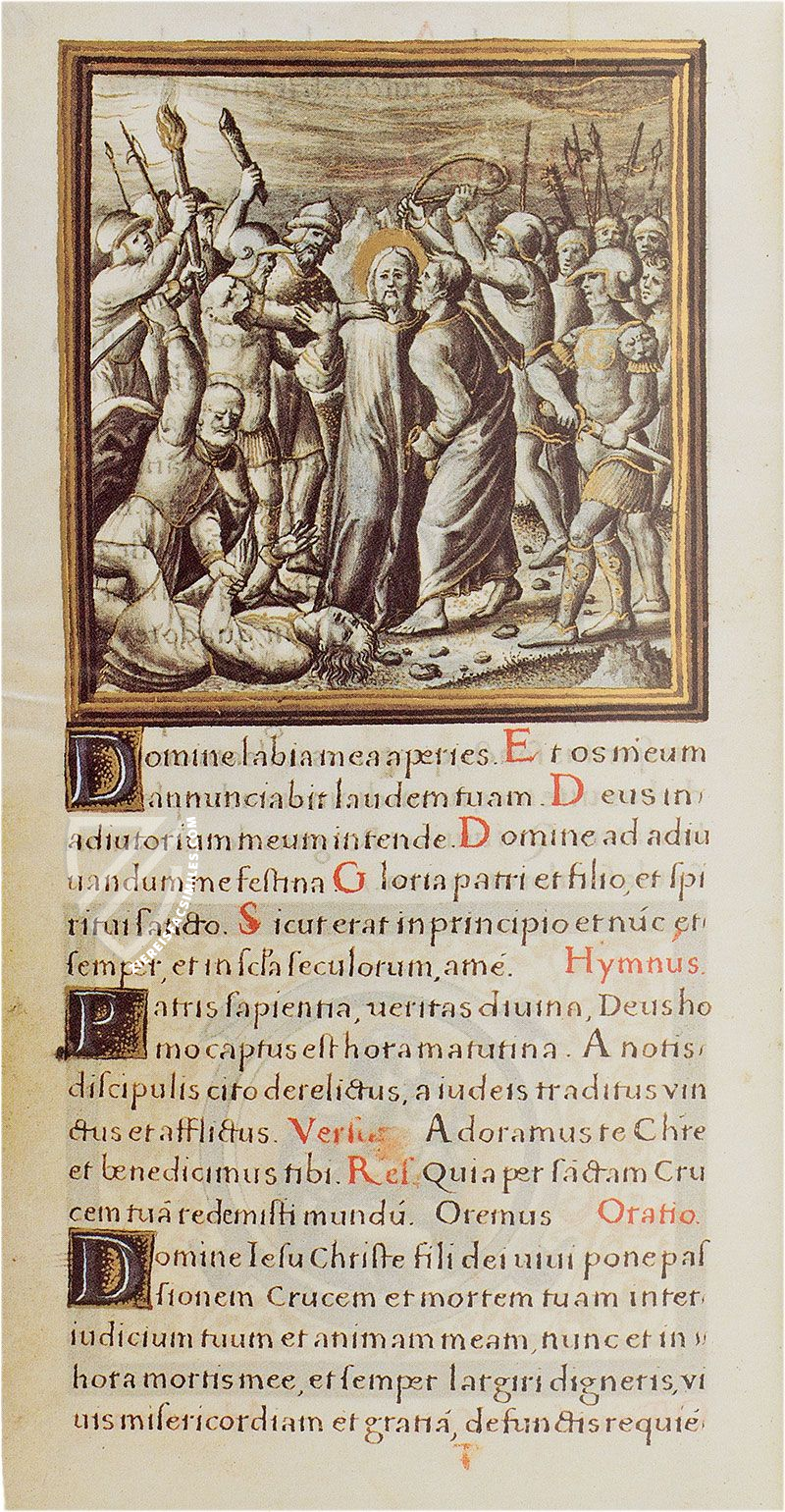
#1 Das jüngere Gebetbuch Kaiser Karls V.
Language: German
The comprehensive commentary was written by Otto Mazal and comes in a case, together with the facsimile in a red binding. It contains a codicological and palaeographic analysis of the manuscript as well as contributions on the artistic decoration and the texts of the prayer book.
Introduction by Otto Mazal, Vienna. 112 pp., 14,3 x 20,3 cm, cloth.
(under 1,000€)
#2 Das jüngere Gebetbuch Kaiser Karls V (Special Edition)
Language: German
The comprehensive commentary was written by Otto Mazal and comes in a case, together with the facsimile in a red binding. It contains a codicological and palaeographic analysis of the manuscript as well as contributions on the artistic decoration and the texts of the prayer book.
Introduction by Otto Mazal, Vienna. 112 pp., 14,3 x 20,3 cm, cloth.
(over 10,000€)
- Treatises / Secular Books
- Apocalypses / Beatus
- Astronomy / Astrology
- Bestiaries
- Bibles / Gospels
- Chronicles / History / Law
- Geography / Maps
- Saints' Lives
- Islam / Oriental
- Judaism / Hebrew
- Single Leaf Collections
- Leonardo da Vinci
- Literature / Poetry
- Liturgical Manuscripts
- Medicine / Botany / Alchemy
- Music
- Mythology / Prophecies
- Psalters
- Other Religious Books
- Games / Hunting
- Private Devotion Books
- Other Genres
- Afghanistan
- Armenia
- Austria
- Belgium
- Belize
- Bosnia and Herzegovina
- China
- Colombia
- Costa Rica
- Croatia
- Cyprus
- Czech Republic
- Denmark
- Egypt
- El Salvador
- Ethiopia
- France
- Germany
- Greece
- Guatemala
- Honduras
- Hungary
- India
- Iran
- Iraq
- Israel
- Italy
- Japan
- Jordan
- Kazakhstan
- Kyrgyzstan
- Lebanon
- Liechtenstein
- Luxembourg
- Mexico
- Morocco
- Netherlands
- Palestine
- Panama
- Peru
- Poland
- Portugal
- Romania
- Russia
- Serbia
- Spain
- Sri Lanka
- Sweden
- Switzerland
- Syria
- Tajikistan
- Turkey
- Turkmenistan
- Ukraine
- United Kingdom
- United States
- Uzbekistan
- Vatican City
- A. Oosthoek, van Holkema & Warendorf
- Aboca Museum
- Ajuntament de Valencia
- Akademie Verlag
- Akademische Druck- u. Verlagsanstalt (ADEVA)
- Aldo Ausilio Editore - Bottega d’Erasmo
- Alecto Historical Editions
- Alkuin Verlag
- Almqvist & Wiksell
- Amilcare Pizzi
- Andreas & Andreas Verlagsbuchhandlung
- Archa 90
- Archiv Verlag
- Archivi Edizioni
- Arnold Verlag
- ARS
- Ars Magna
- ArtCodex
- AyN Ediciones
- Azimuth Editions
- Badenia Verlag
- Bärenreiter-Verlag
- Belser Verlag
- Belser Verlag / WK Wertkontor
- Benziger Verlag
- Bernardinum Wydawnictwo
- BiblioGemma
- Biblioteca Apostolica Vaticana (Vaticanstadt, Vaticanstadt)
- Bibliotheca Palatina Faksimile Verlag
- Bibliotheca Rara
- Boydell & Brewer
- Bramante Edizioni
- Bredius Genootschap
- Brepols Publishers
- British Library
- C. Weckesser
- Caixa Catalunya
- Canesi
- CAPSA, Ars Scriptoria
- Caratzas Brothers, Publishers
- Carus Verlag
- Casamassima Libri
- Centrum Cartographie Verlag GmbH
- Chavane Verlag
- Christian Brandstätter Verlag
- Circulo Cientifico
- Club Bibliófilo Versol
- Club du Livre
- CM Editores
- Collegium Graphicum
- Collezione Apocrifa Da Vinci
- Comissão Nacional para as Comemorações dos Descobrimentos Portugueses
- Coron Verlag
- Corvina
- CTHS
- D. S. Brewer
- Damon
- De Agostini/UTET
- De Nederlandsche Boekhandel
- De Schutter
- Deuschle & Stemmle
- Deutscher Verlag für Kunstwissenschaft
- DIAMM
- Droz
- E. Schreiber Graphische Kunstanstalten
- Ediciones Boreal
- Ediciones Grial
- Ediclube
- Edições Inapa
- Edilan
- Editalia
- Edition Deuschle
- Edition Georg Popp
- Edition Leipzig
- Edition Libri Illustri
- Editiones Reales Sitios S. L.
- Éditions de l'Oiseau Lyre
- Editions Medicina Rara
- Editorial Casariego
- Editorial Mintzoa
- Editrice Antenore
- Editrice Velar
- Edizioni Edison
- Egeria, S.L.
- Eikon Editores
- Electa
- Emery Walker Limited
- Enciclopèdia Catalana
- Eos-Verlag
- Ephesus Publishing
- Ernst Battenberg
- Eugrammia Press
- Extraordinary Editions
- Fackelverlag
- Facsimila Art & Edition
- Facsimile Editions Ltd.
- Facsimilia Art & Edition Ebert KG
- Faksimile Verlag
- Feuermann Verlag
- Folger Shakespeare Library
- Franco Cosimo Panini Editore
- Friedrich Wittig Verlag
- Fundación Hullera Vasco-Leonesa
- G. Braziller
- Gabriele Mazzotta Editore
- Gebr. Mann Verlag
- Gesellschaft für graphische Industrie
- Getty Research Institute
- Giovanni Domenico de Rossi
- Giunti Editore
- Graffiti
- Grafica European Center of Fine Arts
- Guido Pressler
- Guillermo Blazquez
- Gustav Kiepenheuer
- H. N. Abrams
- Harrassowitz
- Harvard University Press
- Helikon
- Hendrickson Publishers
- Henning Oppermann
- Herder Verlag
- Hes & De Graaf Publishers
- Hoepli
- Holbein-Verlag
- Houghton Library
- Hugo Schmidt Verlag
- Idion Verlag
- Il Bulino, edizioni d'arte
- ILte
- Imago
- Insel Verlag
- Insel-Verlag Anton Kippenberger
- Instituto de Estudios Altoaragoneses
- Instituto Nacional de Antropología e Historia
- Introligatornia Budnik Jerzy
- Istituto dell'Enciclopedia Italiana - Treccani
- Istituto Ellenico di Studi Bizantini e Postbizantini
- Istituto Geografico De Agostini
- Istituto Poligrafico e Zecca dello Stato
- Italarte Art Establishments
- Jan Thorbecke Verlag
- Johnson Reprint Corporation
- Josef Stocker
- Josef Stocker-Schmid
- Jugoslavija
- Karl W. Hiersemann
- Kasper Straube
- Kaydeda Ediciones
- Kindler Verlag / Coron Verlag
- Kodansha International Ltd.
- Konrad Kölbl Verlag
- Kurt Wolff Verlag
- La Liberia dello Stato
- La Linea Editrice
- La Meta Editore
- Lambert Schneider
- Landeskreditbank Baden-Württemberg
- Leo S. Olschki
- Les Incunables
- Liber Artis
- Library of Congress
- Libreria Musicale Italiana
- Lichtdruck
- Lito Immagine Editore
- Lumen Artis
- Lund Humphries
- M. Moleiro Editor
- Maison des Sciences de l'homme et de la société de Poitiers
- Manuscriptum
- Martinus Nijhoff
- Maruzen-Yushodo Co. Ltd.
- MASA
- Massada Publishers
- McGraw-Hill
- Metropolitan Museum of Art
- Militos
- Millennium Liber
- Müller & Schindler
- Nahar - Stavit
- Nahar and Steimatzky
- National Library of Wales
- Neri Pozza
- Nova Charta
- Oceanum Verlag
- Odeon
- Orbis Mediaevalis
- Orbis Pictus
- Österreichische Staatsdruckerei
- Oxford University Press
- Pageant Books
- Parzellers Buchverlag
- Patrimonio Ediciones
- Pattloch Verlag
- PIAF
- Pieper Verlag
- Plon-Nourrit et cie
- Poligrafiche Bolis
- Presses Universitaires de Strasbourg
- Prestel Verlag
- Princeton University Press
- Prisma Verlag
- Priuli & Verlucca, editori
- Pro Sport Verlag
- Propyläen Verlag
- Pytheas Books
- Quaternio Verlag Luzern
- Reales Sitios
- Recht-Verlag
- Reichert Verlag
- Reichsdruckerei
- Reprint Verlag
- Riehn & Reusch
- Roberto Vattori Editore
- Rosenkilde and Bagger
- Roxburghe Club
- Salerno Editrice
- Saltellus Press
- Sandoz
- Sarajevo Svjetlost
- Schöck ArtPrint Kft.
- Schulsinger Brothers
- Scolar Press
- Scrinium
- Scripta Maneant
- Scriptorium
- Shazar
- Siloé, arte y bibliofilia
- SISMEL - Edizioni del Galluzzo
- Sociedad Mexicana de Antropología
- Société des Bibliophiles & Iconophiles de Belgique
- Soncin Publishing
- Sorli Ediciones
- Stainer and Bell
- Studer
- Styria Verlag
- Sumptibus Pragopress
- Szegedi Tudomànyegyetem
- Taberna Libraria
- Tarshish Books
- Taschen
- Tempus Libri
- Testimonio Compañía Editorial
- Thames and Hudson
- The Clear Vue Publishing Partnership Limited
- The Facsimile Codex
- The Folio Society
- The Marquess of Normanby
- The Richard III and Yorkist History Trust
- Tip.Le.Co
- TouchArt
- TREC Publishing House
- TRI Publishing Co.
- Trident Editore
- Tuliba Collection
- Typis Regiae Officinae Polygraphicae
- Union Verlag Berlin
- Universidad de Granada
- University of California Press
- University of Chicago Press
- Urs Graf
- Vallecchi
- Van Wijnen
- VCH, Acta Humaniora
- VDI Verlag
- VEB Deutscher Verlag für Musik
- Verlag Anton Pustet / Andreas Verlag
- Verlag Bibliophile Drucke Josef Stocker
- Verlag der Münchner Drucke
- Verlag für Regionalgeschichte
- Verlag Styria
- Vicent Garcia Editores
- W. Turnowski Ltd.
- W. Turnowsky
- Waanders Printers
- Wiener Mechitharisten-Congregation (Wien, Österreich)
- Wissenschaftliche Buchgesellschaft
- Wissenschaftliche Verlagsgesellschaft
- Wydawnictwo Dolnoslaskie
- Xuntanza Editorial
- Zakład Narodowy
- Zollikofer AG

